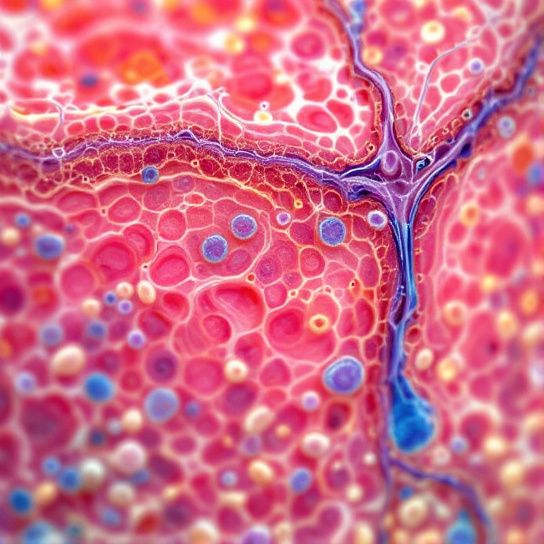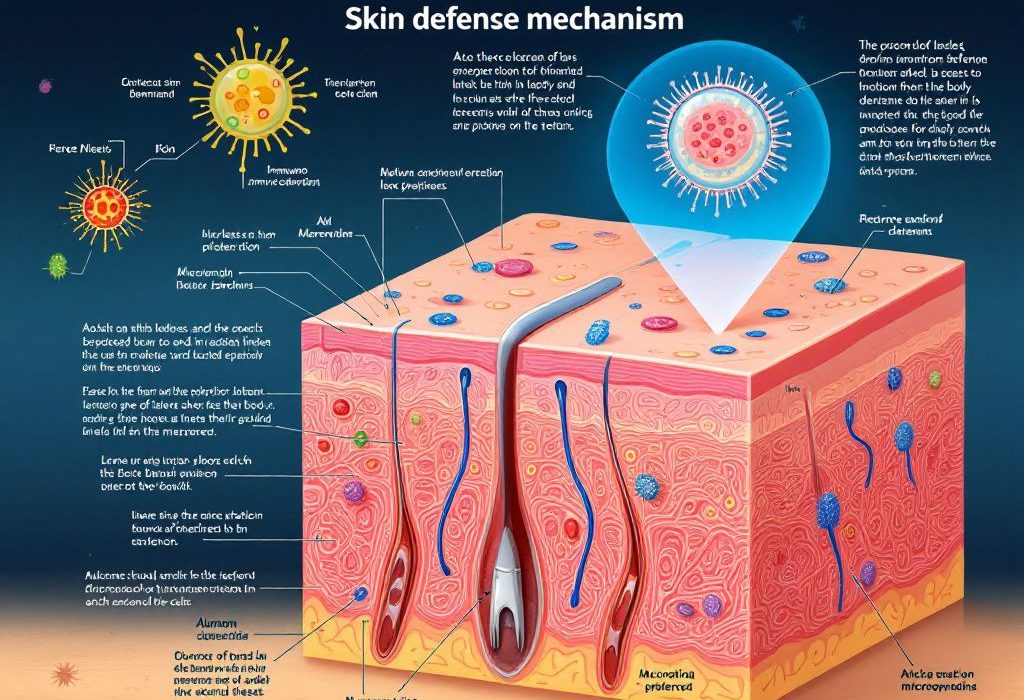Ever wonder why your skin gets all roughed up with rashes or weird yet determined enough to repel some serious assaults from external factors? What superpowers does skin have that it behaves like a fortress for your entire body? Hold up, because we’re about to dive deep into the fascinating world of skin immunity. Trust me, this isn’t your average skincare buzz—we’re looking at something a lot more intricate.
What Is Skin Immunity Anyway?
At its core, skin immunity is your body’s very first bodyguard before the cavalry comes in—that’s your internal immune system by the way. Picture a bustling city center: your skin is City Hall, constantly vigilant and managing all sorts of visitors and intruders. The whole business of protecting you falls on this incredible, multifunctional organ playing more defense moves than a football team in playoffs. The term “skin immunity” refers to the mechanisms that the skin employs to keep the bad guys out—whether they are harmful UV rays or nasty microbes.
The Layers: Meet Your Skin’s Defense Squad
To grasp how skin immunity functions, let’s unravel the layers quickly:
- Epidermis: This outer layer is like a highly organized checkpoint, denying entry to most harmful substances on initial contact. It consists of many dead cells that act like shields.
- Dermis: Move deeper, and you’re in the realm of sebaceous glands and collagen—this dynamic duo provides resilience and a certain suppleness. It’s almost like a cushion that absorbs impacts.
- Hypodermis: This deeper fat layer provides insulation, and if the epidermis and dermis blow their coverage, the hypodermis jumps in to mitigate the effects.
And smack within these layers are cells specialized in immunity—those sneaky, undetected soldiers fighting silently. Marvelous, isn’t it?

Fun Fact: The Microbiome Universe
Have you ever caught yourself opting for antibacterial products thinking it was a good idea to kick germs to the curb? Surprise! Well, your skin actually harbors countless microorganisms, and no, they’re not plotting a rebellion. They form what’s called the “skin microbiome.” Imagine it as your skin’s roommate ecosystem, where most of the occupants are pretty friendly.
These beneficial bugs serve your skin like those vigilant comrades who’ll watch your back. They help fend off intruders who dare disrupt the harmony and share resources, boosting your skin’s immune response. So next time reaching for that antibacterial scrub, maybe just pause and consider the friendly fire you could be causing!
How Skin Immunity Works: Navigating First Contact
Upon confronting potential threats, your standard skin defenders kick into action—those initial avengers include physical barriers like your epidermis and the slick team of chemicals like enzymes and acids. These substances straight up disarm and neutralize threats before they dare reach anywhere crucial.
In this line-up, immune cells in your skin such as Langerhans cells patrol for pathogens. They’re like security scanners at your skin’s checkpoints. They identify invaders and roll in reinforcements from your central immune system for more heavy-duty dealings. Just imagine them pressing an internal button saying, “We’re gonna need backup!”
Watch Out for Moisture: Your BFF
Want to keep this defense squad in peak performance? Keep your skin hydrated. Moisture assists in maintaining the barrier function, making it tougher for unwanted guests to break in. When skin gets dry or cracked, it’s like opening windows to all sorts of trespassers—yikes!
Pro Tip: DIY Skin Fortress Maintenance
Hydration’s not just about drinking gallons of water—although hydrating is crucial. Think about incorporating emollient-rich, fragrance-free moisturizers into your routine to retain moisture and strengthen your shield. And don’t overdo it with harsh soaps; simple is sometimes best, especially when speaking ‘skin language’.

Your Lifestyle Choice: Companions or Opponents?
Could your habits be training that again each other? Probably. Lifestyle choices go hand in glove with the abilities of your skin immunity. Stress levels, diet, environmental exposure, and sleeping patterns influence how proactive your skin is in defense strategies.
1. Stress: A Double-Agent for Trouble
Cortisol, the stress hormone, can put a hold on your skin’s beloved line of duty when it’s roaming around in excess. Nudge stress to the “keep cool, don’t panic” register through activities like meditation or light exercise.
2. Diet: Your Skin’s Energy Bar
Our gut and skin are more gossipers than we think. A balanced diet rich in antioxidants (think blueberries, spinach) and Omega-3 fatty acids (like in salmon and walnuts) can promote a healthy skin microbiome which in turn enhances immunity. Bonus pick: Vitamin-rich foods—like those loaded with A, C, D, and E—keep your defenses peppy and persistent.
3. Sleep: The Repair Team
Funny enough, your skin pulls late-night shifts. During sleep, the body repairs cells and renews collagen—the fat-saving time machines eradicating all sorts of threats while restoring firmness.
4. Environment: The Hidden Assassin
Pollution, UV exposure (yeah, that sunshine we’re all obsessed with), and temperature flares put your skin on an all-day siege runs. Slight changes in your environment claim a big chunk of skin resilience. Shield yourself with proper sunscreen—even on cloudy days—and throw in some antioxidant serums.

Recognizing When Help Is Needed: A Konical Sign
Okay, you’ve learned to celebrate your skin’s defense prowess, nourish these efforts with thoughtful hydration and diet, but what if it signals S.O.S.? A force overload?
Telltale Signs Your Skin’s Seeking Backup:
- Persistent Redness or Rash: Could imply allergies or conditions like eczema. Your tidy patrol team crying for extra reinforcements.
- Continuously Itchy Skin: Itchiness indicates inflammation, possibly soon to result in infection if unattended.
- Cracks or Sores: Signs that defense barriers are without enhancements.
Act Fast with Games Stronger Than DIY-Kit
In earnest, consulting a dermatologist when those alarms blare is a staple to fortify your remedy loads. Topicals specifically designed for boosting immuno barrier features could offer soothing results when everyday measures toughen vectors.
In Closing: Cultivating Resilience Together
Cherishing your skin’s immunity involves recognizing it as a partnership rather than an isolated event. We didn’t quite mention dragons or mythical quests but let’s say building a defense army, now, doesn’t it make you prodigious in a very human way? Appreciate your skin beyond what it looks like; remember all that it does. This daily foot soldier stands at rendezvous benefiting the bustling vistas of internal immunity we often don’t see.
And just like aligning to ideal goals in hustle, lend it the support it duly merits—balance acts well in diet, sleep, faltering stressors away with but a firm foot against them, and acknowledging environmental battles with poise. Push through those everyday UV filters and hydration nudges, giving meaning to colorless essentials alike.
Nurture the everyday relationship with clear goals around protection defending, hydration leading, rest calling, and nutritional healing methods—ideal treasures guiding the future journal of exploration toward enviable encompassing health. By understanding, revering, and supporting skin immunity, you’re not just showing external beauty some love—but empowering the entrusted bodyguard keeping watch from behind the scenes.
Frequently Asked Questions
What is skin immunity?
Skin immunity is a complex defense system that includes physical barriers, immune cells, and signaling molecules. It protects the body from infections, allergens, and environmental damage by providing both innate and adaptive immune responses. The skin acts as a dynamic organ with various cells, including keratinocytes, Langerhans cells, and other immune cells, which work together to resist and fight infections[1][4][5).
How does the skin microbiota influence skin immunity?
The skin microbiota plays a crucial role in skin immunity by enhancing the immune response and providing protection against pathogens. Specific bacteria, such as *Staphylococcus epidermidis*, promote the activation and expansion of T cell subsets, improve innate immune barriers, and produce cell-signaling molecules that help combat harmful microbes. The presence of these commensal bacteria is essential for maintaining effective skin immune function[1][2).
What are the key components of the skin’s immune system?
The key components of the skin’s immune system include the physical barrier of the skin itself, immune cells such as keratinocytes, Langerhans cells, and macrophages, and signaling molecules like cytokines and chemokines. These elements work together to detect pathogens, trigger inflammatory responses, and coordinate both innate and adaptive immune reactions[1][4][5).
How can skin immunity be compromised, and what are the consequences?
Skin immunity can be compromised by various factors, including the absence or imbalance of skin microbiota, genetic disorders, and environmental stressors. This compromise can lead to impaired immune responses, making the skin more susceptible to infections and inflammatory diseases. For example, germ-free mice have shown an impaired capacity to respond to infections compared to mice with normal skin microbiota[1][2]).
References


